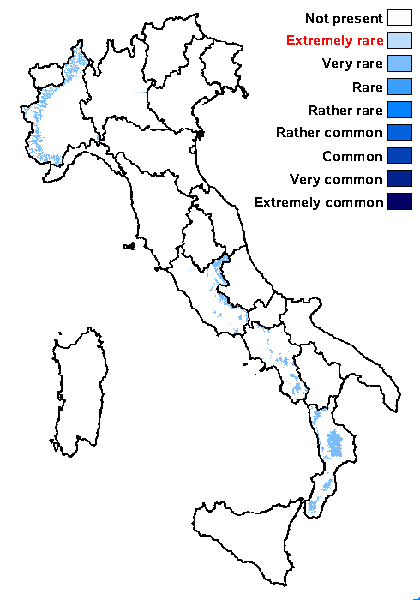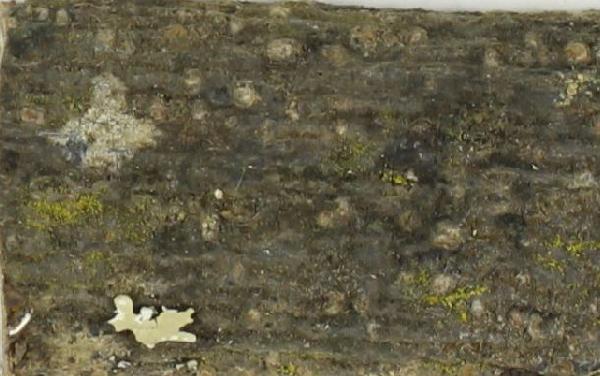Scoliciosporum perpusillum Körb.
J. Lahm ex Körb., Parerga Lichenol.: 241, 1861.
Synonyms: Bacidia perpusilla (Körb.) Th. Fr.
Distribution: N - Piem (Matteucci & al. 2013). C - Laz (TSB 4208). S - Camp (Aprile & al. 2003b), Cal (Puntillo 1996).
Description: Thallus crustose, thinly episubstratic, granular, yellowish green. Apothecia biatorine, 0.1-0.3 mm across, with a soon convex, red-brown to black disc, without an evident proper margin. Proper exciple thin, olive brown in section, without crystals, of radiating, branched and anastomosing hyphae; epithecium olive-brown to brown; hymenium colourless, I+ blue; paraphyses strongly branched and anastomosing up to the upper part, immersed in a gelatinous matrix and resembling excipular hyphae, the apical cells mostly slightly clavate; hypothecium colourless to flesh-coloured. Asci 8-spored, broadly clavate, surrounded by a gelatinous, amyloid sheet, with a well-developed, amyloid tholus containing a widely cylindrical axial body and a poorly developed, bluntly conical ocular chamber, more or less Lecanora-type. Ascospores 3-7-septate, with rather indistinct septa, hyaline, acicular, curved or slightly spirally twisted, 28-40 x 2.5-3 μm. Photobiont chlorococcoid. Spot tests: thallus K-, C-, KC-, P-, UV-. Chemistry: without lichen substances.Note: a mild-temperate, probably western species, generally found on acid bark, especially of conifers, but also on needles of Abies in damp montane forests. The length of spores, not specified in the protologue, is 15-20 μm according to Lindau (1913) and Nowak & Tobolewski (1975), while Dymytrova (2011) cites lengths of (14–)28-40 μm. It is included in the Italian red list of epiphytic lichens as “Vulnerable” (Nascimbene & al. 2013c).
Growth form: Crustose
Substrata: bark and leaves
Photobiont: green algae other than Trentepohlia
Reproductive strategy: mainly sexual
Most common in areas with a humid-warm climate (e.g. most of Tyrrenian Italy)
Commonnes-rarity: (info)
Alpine belt: absent
Subalpine belt: absent
Oromediterranean belt: absent
Montane belt: very rare
Submediterranean belt: absent
Padanian area: absent
Humid submediterranean belt: absent
Humid mediterranean belt: absent
Dry mediterranean belt: absent

Predictive model
Herbarium samples
Growth form: Crustose
Substrata: bark and leaves
Photobiont: green algae other than Trentepohlia
Reproductive strategy: mainly sexual
Most common in areas with a humid-warm climate (e.g. most of Tyrrenian Italy)
Commonnes-rarity: (info)
Alpine belt: absent
Subalpine belt: absent
Oromediterranean belt: absent
Montane belt: very rare
Submediterranean belt: absent
Padanian area: absent
Humid submediterranean belt: absent
Humid mediterranean belt: absent
Dry mediterranean belt: absent

Predictive model
| Herbarium samples |


